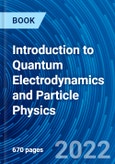Apart from updating the existing text of the 1st edition two new chapters, namely, Mandelstam Variables and Symmetries of Scattering Amplitude and Regge Poles have been included in this edition. The former, which constitutes the seventh chapter of the book, introduces Mandelstam variables and describes at length the s-channel, t-channel and the u-channel processes for both the equal and unequal masses of participating particles. The conditions for the occurrence of these channel processes have been made explicit through the Mandelstam plot. Introducing scattering amplitude as the matrix element of S-matrix, the crossing and Bose symmetries of scattering amplitudes for s-, t-, u-channel scatterings have been explained and the analyticity of scattering amplitude has been elucidated through examples.
The topic Regge poles, describes the study of resonances and Regge poles that can be undertaken through the scattering process. Due to the significant role of partial waves in the chapter, the scattering process has been explained through the partial wave analysis and the scattering cross section has been expressed in terms of scattering amplitude and by the optical theorem.
Assignments have been given at the end of each chapter, which contains descriptive questions as well as problems. A new feature of the book is that it has a substantial number of objective type questions to help aspirants of GATE, NET and related examinations.
Most of the topics forming the model syllabus of the University Grants Commission for Post Graduate Particle Physics (III Semester), Nuclear and Particle Physics (IV Semester, Strong, Weak and Electromagnetic Interactions)
and Quantum Electrodynamics have been covered in the book. The topics have been developed in a pedagogical manner by providing all possible algebraic details.
The topic Regge poles, describes the study of resonances and Regge poles that can be undertaken through the scattering process. Due to the significant role of partial waves in the chapter, the scattering process has been explained through the partial wave analysis and the scattering cross section has been expressed in terms of scattering amplitude and by the optical theorem.
Assignments have been given at the end of each chapter, which contains descriptive questions as well as problems. A new feature of the book is that it has a substantial number of objective type questions to help aspirants of GATE, NET and related examinations.
Most of the topics forming the model syllabus of the University Grants Commission for Post Graduate Particle Physics (III Semester), Nuclear and Particle Physics (IV Semester, Strong, Weak and Electromagnetic Interactions)
and Quantum Electrodynamics have been covered in the book. The topics have been developed in a pedagogical manner by providing all possible algebraic details.
Audience Includes:
- Postgraduate students of Physics, and aspirants of GATE, NET and related examinations
Table of Contents
1. Elementary Particles2. Quantum Electrodynamics
3. Symmetries and Groups
4. Weak Interactions
5. Gauge Symmetries
6. The Standard Model
7. Mandelstam Variables and Symmetries of Scattering Amplitude
8. Regge Poles
Appendices
Appendix A: Conventions
Appendix B: Green's Functions of Field Theory
Appendix C: Schwinger's Action Principle
Appendix D: Electromagnetic Field
Appendix E: Continuous and Discrete Symmetries
Bibliography
Index
Author
- Deep Chandra Joshi








